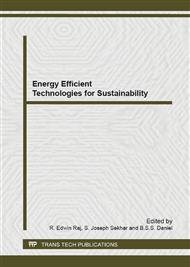p.80
p.84
p.90
p.98
p.103
p.109
p.119
p.124
p.131
Influence of Source - Substrate Distance of Cu4SnS4 Thin Films Grown by Co-Evaporation
Abstract:
Copper tin sulphide (Cu4SnS4) thin films were prepared on glass substrates by the thermal co-evaporation technique by varying the source - substrate distance (SSD) in the range, 10 25 cm at a constant substrate temperature of 400°C. The influence of SSD on the chemical as well as physical properties of as-grown Cu4SnS4 films was investigated. The EDS analysis revealed that the evaporated films are stoichiometric at a SSD of 20 cm. X-ray diffraction analysis confirmed the presence of Cu4SnS4 phase in the layers following the orthorhombic crystal structure. The films showed a strong (311) peak as the preferred orientation. The evaluated crystallite size of the films decreased with the increase of SSD. From the SEM analysis, it was observed that needle like grains were distributed on the surface of the substrate and its size decreased with increasing SSD. The energy band gap was estimated using the optical transmittance data that varied in the range, 1.25 1.34 eV with the change of SSD.
Info:
Periodical:
Pages:
103-108
Citation:
Online since:
September 2013
Keywords:
Price:
Сopyright:
© 2013 Trans Tech Publications Ltd. All Rights Reserved
Share:
Citation:


